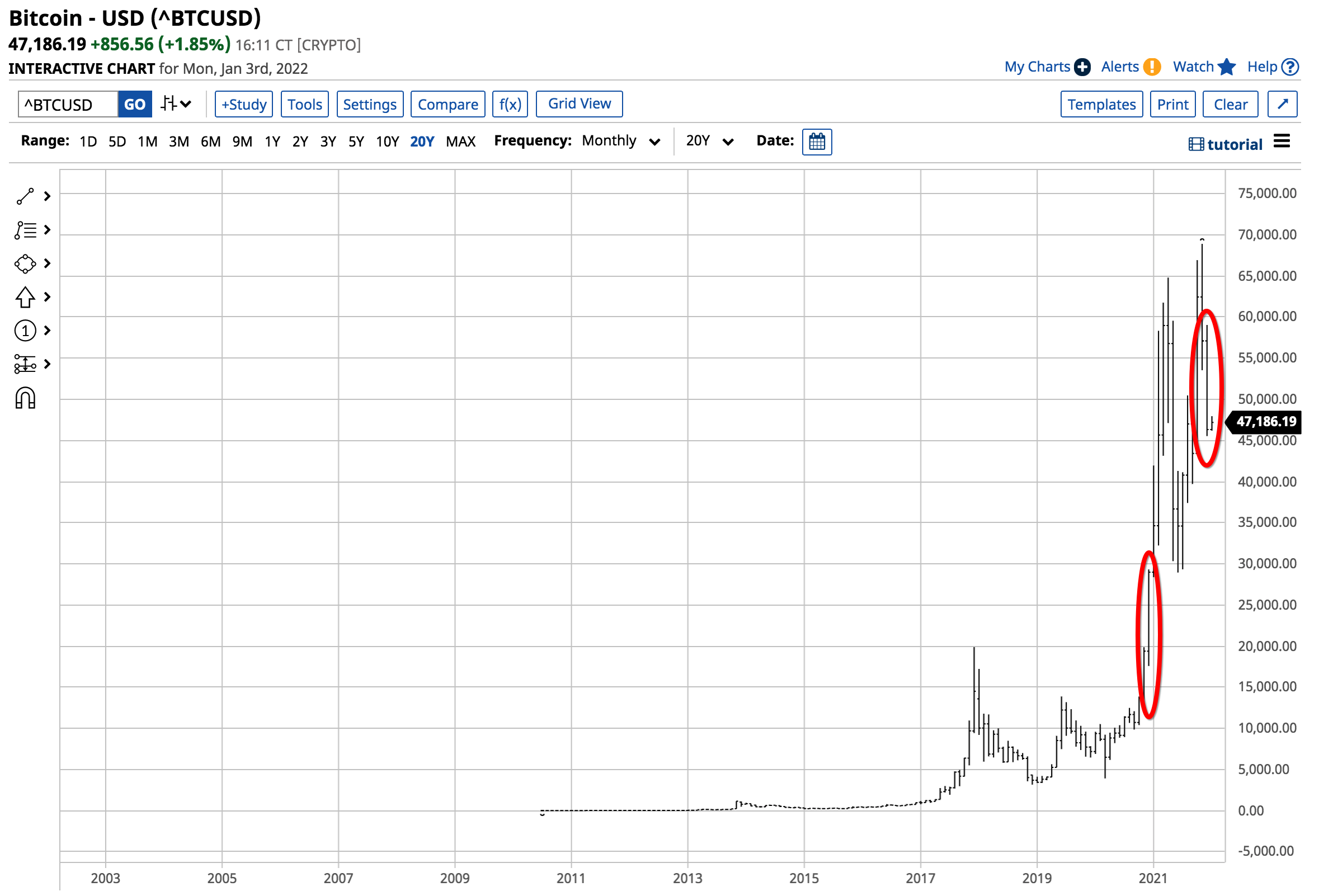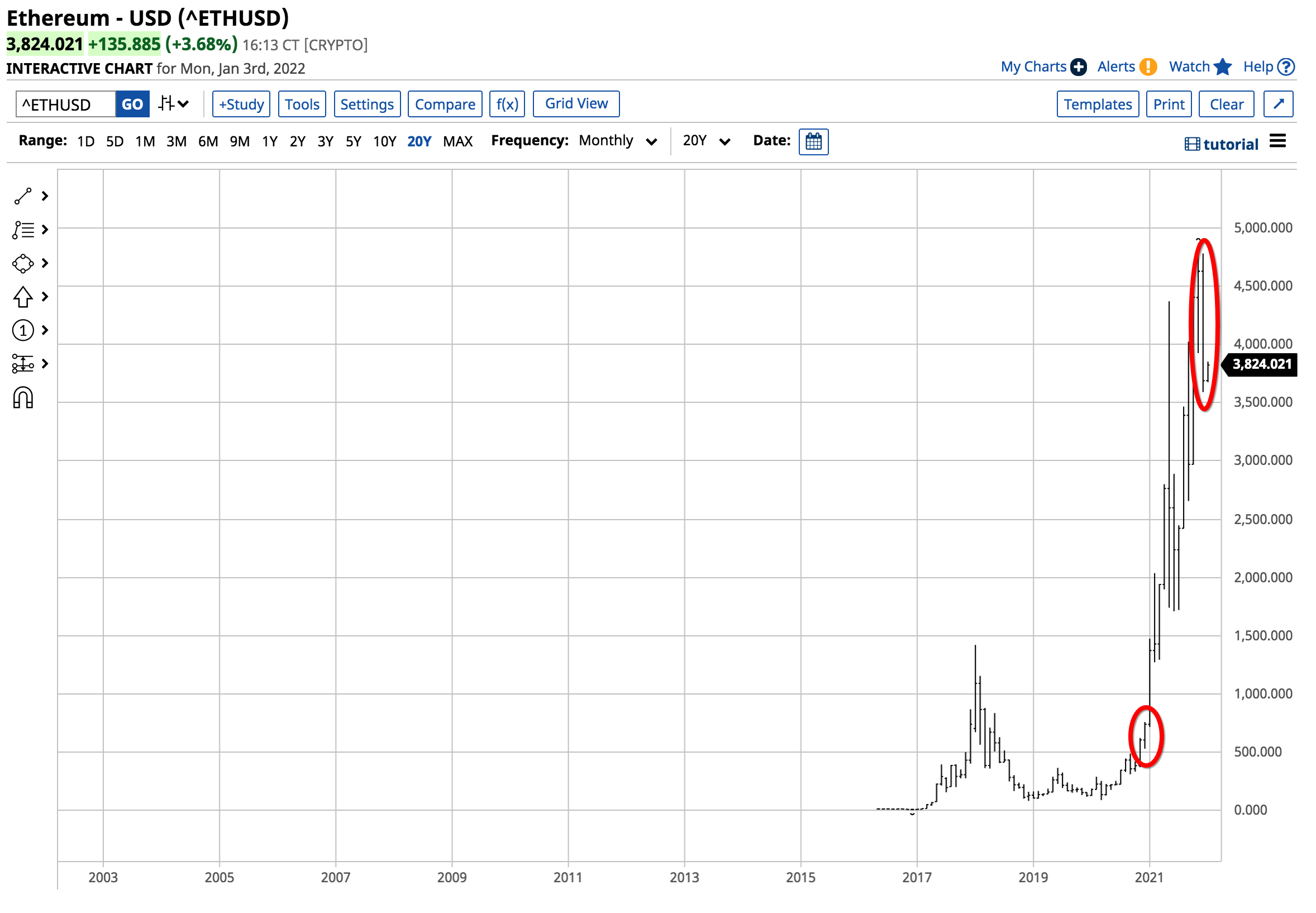This article was written exclusively for Investing.com
- Substantial rise in cryptocurrency market cap during 2021
- Market acceptance accelerated
- Speculative frenzy continues to drive prices higher
- Regulators eyeing the burgeoning asset class
- Money supply control a critical factor for governments; the higher the market cap, the greater the concerns
Bitcoin and Ethereum are the two leading cryptocurrencies. At the end of 2021, they accounted for over 60% of the overall asset class’s market cap. At the $47,000 level, Bitcoin’s value was near $894 billion. At $3,715 per token, Ethereum’s market cap stood at almost $445 billion.
Together, as the year came to a close, the two accounted for nearly $1.34 trillion of the $2.223 trillion value of the burgeoning asset class.
Meanwhile, Apple (NASDAQ:AAPL), the world’s largest company at the end of 2021, had a market valuation of $2.913 trillion at $177.57 per share on Dec. 31, 2021. The entire cryptocurrency asset class was still smaller than the value of the leading publicly-traded company, but it was nipping at its heels.
As we move into 2022, a continuation of growth in the digital currency asset class is likely to increase concerns from governments worldwide over “systemic risks” created by cryptos. However, the primary concern remains controlling the money supply as the asset class poses an increasing threat to fiat currencies.
Substantial rise in cryptocurrency market cap during 2021
According to CoinMarketCap, at the end of 2020, the market cap of the cryptocurrency asset class stood at $767.482 billion. On Dec. 31, 2021, it was over $2.223 trillion, as the value rose nearly 2.9 times.
Bitcoin, the asset class leader, posted an impressive gain for the year, but closed well below the Nov. 10 all-time high. 
Source: Barchart
The chart highlights the rise from $28,986.74 on Dec. 31, 2020, to $46,329.11 at the end of 2021, a 59.83% increase. However, Bitcoin closed 32.77% lower than its all-time peak on Nov. 10 of $68,906.48.
Ethereum, meanwhile, did even better in 2021.

Source: Barchart
Ethereum rose from $738.912 at the end of 2020 to $3,688.877 on Dec. 31, 2021. The second-leading crypto moved nearly five times higher. Bitcoin underperformed the overall asset class in 2021, while Ethereum outperformed.
Bitcoin is a means of exchange, while Ethereum’s protocol is a platform for many of the over 16,200 tokens. Ethereum is faster, more efficient, and with its upcoming release, Ethereum 2.0 will be a greener crypto as it requires far less energy to mine via the proof of stake mechanism.
Market acceptance accelerated
The growth of the asset class reflects a rejection of fiat currencies in a year during which inflation gripped markets, eroding the value of the US dollar, euro, pound, yen, and most other fiat means of exchange. Cryptocurrency values are a function of pure supply and demand without any intervention from governments.
While the speculative frenzy created by the bullish price action pushed cryptos higher, growing comfort with tokens as acceptable payment for goods and services played a role in the growth.
Support from Block’s (NYSE:SQ) CEO Jack Dorsey and Tesla’s (NASDAQ:TSLA) founder and chief executive Elon Musk were factors that assisted the gains. As of the end of 2021, a growing number of companies accept cryptos as payment, with many companies holding reserves of the leading tokens and more and more investors allocating a percentage of portfolios in cryptos, which have become an inflation hedge.
Speculative frenzy continues to drive prices higher
Nothing gets a market going on the upside like a bullish trend. Bitcoin’s rise from five cents in 2010 to nearly $47,000 at the end of 2021 means a $100 investment eleven years ago was worth $94 million on Dec. 31, 2021.
Incredible returns have caused speculators to flock to the volatile crypto asset class. If the trend continues in 2022 and beyond, speculators’ appetites will only grow. Bull markets tend to feed on themselves as the potential for wealth is a magnetic force.
Regulators eyeing the burgeoning asset class
In finance, systemic risk is the hazard of the collapse of an entire financial system or total market, as opposed to the risk associated with just one individual entity, group, or component of a system. A single disintegration or collapse could be contained within the network without harming the entire system.
At the end of 2021, at the $2.223 trillion level, the total value of cryptocurrencies was still below the market cap of the world’s leading company, Apple, thus posing little systemic risk to the financial system. Though the volatile crypto asset class entails plenty of risks, its collapse would not cause an economic calamity at the current level.
Meanwhile, if the asset class sustains the same rate of growth as it did in 2021, that could be another story. If the market cap grows at the same or similar rate—to $6.447 trillion by the end of 2022—regulators will likely take measures to control the systemic risks of a sudden collapse.
Money supply control a critical factor for governments; the higher the market cap, the greater the concerns
While government officials worldwide will cite systemic risks as a reason for putting a leash on cryptocurrencies if the market cap continues to increase, another far more serious issue will spur them into action.
Governments derive power from their military and control of the purse strings. Expanding or contracting the money supply yields significant power as it allows for economic stimulation or contraction. A rising market cap for cryptocurrencies comes at the expense of fiat currencies that derive value from the full faith and credit of the governments that issue the legal tender.
The bottom line: cryptos grow at the expense of fiat currencies. Governments are unlikely to surrender one of their instruments of power to individuals. At the same time, ideological crypto devotees have precisely that intention.
The higher the crypto market cap rises; the more chance governments will step in to control what they likely see as an economic enemy that threatens their power and control. In 2021, hedge fund manager Ray Dalio may have said it best when he said about the crypto class:
“I think at the end of the day if it’s really successful, they will kill it, and they will try to kill it. And I think they will kill it because they have ways of killing it.”
In 2022, a continuation of growth and higher crypto prices could set the stage for an epic battle between the asset class and governments, which could cause lots of volatility. Only invest capital you can afford to lose, as fighting governments is a dangerous game.
The tipping point for the market cap could be as low as $3 trillion and as high as $5 trillion in 2022. The last thing any government is willing to surrender is its power and control of the money supply, making cryptocurrencies a perilous financial arena.
Meanwhile, digital fiat currencies could be the new wave that becomes fintech’s compromise. However, ideological differences will continue to draw battle lines as finance evolves over the coming year.
